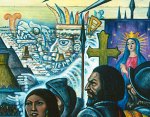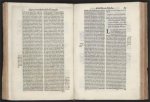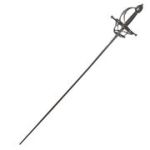The Big Men……….et al.
William H. Prescott’s work is, at a very basic level, “big man” history at its finest. In this regard both Montezuma and Cortes are the works two chief protagonists. For Prescott, both epitomize their respective civilizations. Perhaps the exchange between the two in Tenochtitlan wherein Montezuma comments on their joint lack of divinity best summarizes Prescott’s take on the character of an individual who dramatically shapes history. Though both are mortal, flesh and blood, for Prescott both exceeded their worldly limitations: thus the digressions on each individual’s character. Aside from these two, who are by turns tragic, heroic, or even both, there are foils for both and the mass of their followers.
I envision the mechanism of history for Prescott as two massive pyramids with both protagonists at their pinnacle, tapering into the mists of the past as one get further and further from the top. Other figures are visible, especially in Cortes’s camp, but the tragically wrong Spanish civilization, perhaps blessed by vestigial traces of romanitas, must collide with the enticingly noble but benighted, sanguine heathen of Mexico. For Prescott the outcome is never in question, except where dramatic device demands anxiety.
In this narrative it would be fairly easy to outline Prescott’s goals and his craft. The man is obviously an utter master of language. The potency of his ability makes the story intrinsically appealing. The reader feels in the company of the great narrators of the classical past: Pliny, Suetonius, Caesar, and Plutarch. Prescott’s flowering verbosity and his eye for detail weave a spell in a literal sense. The question that I must ask myself after all this has wilted is a difficult one: What can I learn from Prescott? For many even today this type of work would be considered the pinnacle of historical writing. An engaging narrative is often sought by a popular audience. One that appeals to an ideology of self-reliance and perseverance in the face of barbaric and indomitable odds is doubly so. Yet Prescott’s work doesn’t seem so cut and dry to me. What of the Tlascalans? Are they ennobled by Cortes, or do they lend a needed ferocity to the more (albeit not entirely) civilized Spaniards? I think in these places, where there is a blurring or shift in his treatment of psychological drive, the essential nature of his protagonist(s), a greater understanding of the man and his times can be found. Is the ultimate end of a discussion of his history an understanding of Prescott and his times? Not entirely, but it’s a beginning.





